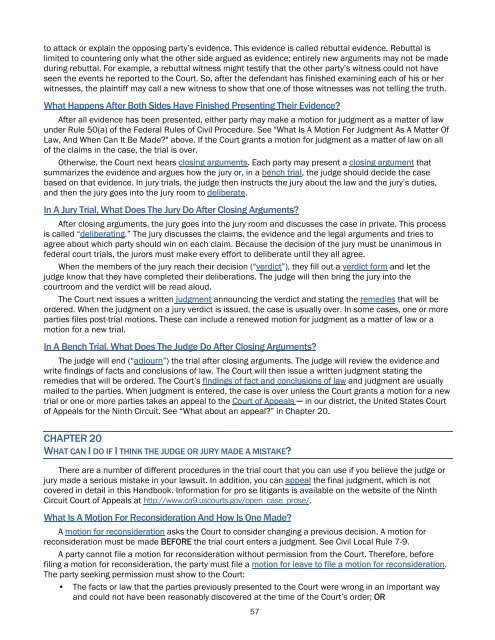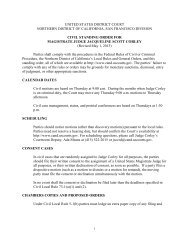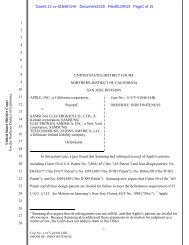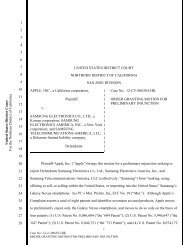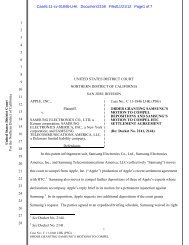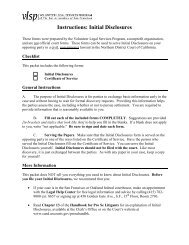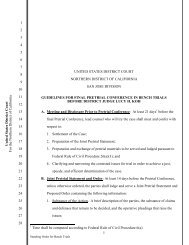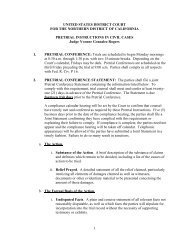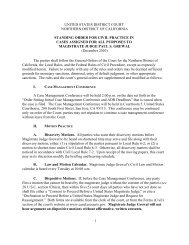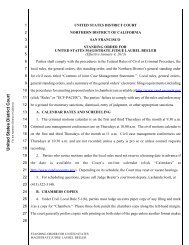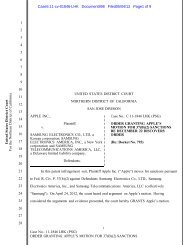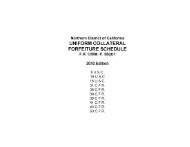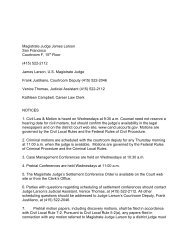Representing Yourself in Federal Court - United States District Court ...
Representing Yourself in Federal Court - United States District Court ...
Representing Yourself in Federal Court - United States District Court ...
You also want an ePaper? Increase the reach of your titles
YUMPU automatically turns print PDFs into web optimized ePapers that Google loves.
to attack or expla<strong>in</strong> the oppos<strong>in</strong>g party’s evidence. This evidence is called rebuttal evidence. Rebuttal is<br />
limited to counter<strong>in</strong>g only what the other side argued as evidence; entirely new arguments may not be made<br />
dur<strong>in</strong>g rebuttal. For example, a rebuttal witness might testify that the other party’s witness could not have<br />
seen the events he reported to the <strong>Court</strong>. So, after the defendant has f<strong>in</strong>ished exam<strong>in</strong><strong>in</strong>g each of his or her<br />
witnesses, the pla<strong>in</strong>tiff may call a new witness to show that one of those witnesses was not tell<strong>in</strong>g the truth.<br />
What Happens After Both Sides Have F<strong>in</strong>ished Present<strong>in</strong>g Their Evidence?<br />
After all evidence has been presented, either party may make a motion for judgment as a matter of law<br />
under Rule 50(a) of the <strong>Federal</strong> Rules of Civil Procedure. See "What Is A Motion For Judgment As A Matter Of<br />
Law, And When Can It Be Made?" above. If the <strong>Court</strong> grants a motion for judgment as a matter of law on all<br />
of the claims <strong>in</strong> the case, the trial is over.<br />
Otherwise, the <strong>Court</strong> next hears clos<strong>in</strong>g arguments. Each party may present a clos<strong>in</strong>g argument that<br />
summarizes the evidence and argues how the jury or, <strong>in</strong> a bench trial, the judge should decide the case<br />
based on that evidence. In jury trials, the judge then <strong>in</strong>structs the jury about the law and the jury’s duties,<br />
and then the jury goes <strong>in</strong>to the jury room to deliberate.<br />
In A Jury Trial, What Does The Jury Do After Clos<strong>in</strong>g Arguments?<br />
After clos<strong>in</strong>g arguments, the jury goes <strong>in</strong>to the jury room and discusses the case <strong>in</strong> private. This process<br />
is called “deliberat<strong>in</strong>g.” The jury discusses the claims, the evidence and the legal arguments and tries to<br />
agree about which party should w<strong>in</strong> on each claim. Because the decision of the jury must be unanimous <strong>in</strong><br />
federal court trials, the jurors must make every effort to deliberate until they all agree.<br />
When the members of the jury reach their decision (“verdict”), they fill out a verdict form and let the<br />
judge know that they have completed their deliberations. The judge will then br<strong>in</strong>g the jury <strong>in</strong>to the<br />
courtroom and the verdict will be read aloud.<br />
The <strong>Court</strong> next issues a written judgment announc<strong>in</strong>g the verdict and stat<strong>in</strong>g the remedies that will be<br />
ordered. When the judgment on a jury verdict is issued, the case is usually over. In some cases, one or more<br />
parties files post-trial motions. These can <strong>in</strong>clude a renewed motion for judgment as a matter of law or a<br />
motion for a new trial.<br />
In A Bench Trial, What Does The Judge Do After Clos<strong>in</strong>g Arguments?<br />
The judge will end (“adjourn”) the trial after clos<strong>in</strong>g arguments. The judge will review the evidence and<br />
write f<strong>in</strong>d<strong>in</strong>gs of facts and conclusions of law. The <strong>Court</strong> will then issue a written judgment stat<strong>in</strong>g the<br />
remedies that will be ordered. The <strong>Court</strong>’s f<strong>in</strong>d<strong>in</strong>gs of fact and conclusions of law and judgment are usually<br />
mailed to the parties. When judgment is entered, the case is over unless the <strong>Court</strong> grants a motion for a new<br />
trial or one or more parties takes an appeal to the <strong>Court</strong> of Appeals ─ <strong>in</strong> our district, the <strong>United</strong> <strong>States</strong> <strong>Court</strong><br />
of Appeals for the N<strong>in</strong>th Circuit. See “What about an appeal?” <strong>in</strong> Chapter 20.<br />
CHAPTER 20<br />
WHAT CAN I DO IF I THINK THE JUDGE OR JURY MADE A MISTAKE?<br />
There are a number of different procedures <strong>in</strong> the trial court that you can use if you believe the judge or<br />
jury made a serious mistake <strong>in</strong> your lawsuit. In addition, you can appeal the f<strong>in</strong>al judgment, which is not<br />
covered <strong>in</strong> detail <strong>in</strong> this Handbook. Information for pro se litigants is available on the website of the N<strong>in</strong>th<br />
Circuit <strong>Court</strong> of Appeals at http://www.ca9.uscourts.gov/open_case_prose/.<br />
What Is A Motion For Reconsideration And How Is One Made?<br />
A motion for reconsideration asks the <strong>Court</strong> to consider chang<strong>in</strong>g a previous decision. A motion for<br />
reconsideration must be made BEFORE the trial court enters a judgment. See Civil Local Rule 7-9.<br />
A party cannot file a motion for reconsideration without permission from the <strong>Court</strong>. Therefore, before<br />
fil<strong>in</strong>g a motion for reconsideration, the party must file a motion for leave to file a motion for reconsideration.<br />
The party seek<strong>in</strong>g permission must show to the <strong>Court</strong>:<br />
• The facts or law that the parties previously presented to the <strong>Court</strong> were wrong <strong>in</strong> an important way<br />
and could not have been reasonably discovered at the time of the <strong>Court</strong>’s order; OR<br />
57


